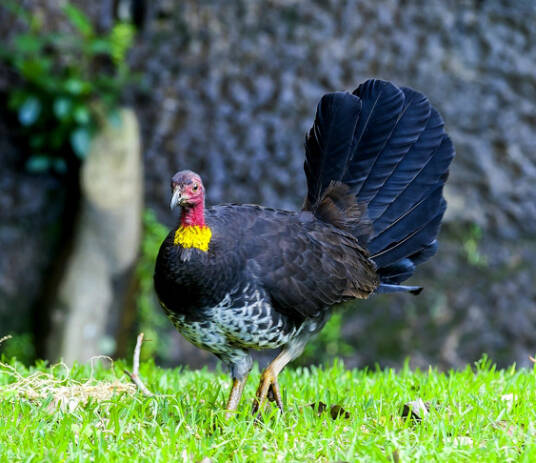Australian Brush-turkey
IUCN
LCBasic Information
Scientific classification
- name:Australian Brush-turkey
- Scientific Name:Australian Brush-turkey,Alectura lathami
- Outline:Landfowl
- Family:Chickeniformes Megapodontidae Megapodontidae
Vital signs
- length:60-70cm
- Weight:1.98-2.95kg
- lifetime:No textual research information is available
Feature
Thin neck, bare skin, bright color
Distribution and Habitat
It is found in eastern and northeastern Australia. It usually inhabits closed tropical rainforest coastal areas, tropical and warm temperate areas. No migration, forest dwelling.
Appearance
The pheasant is 60-70 cm long; Male 2120-2950 g, female 1980-2510 g. Slender, it is a pheasant-like bird with mostly black plumage, a thin neck, and exposed skin with bright colors. The neck overhang is a pile of wrinkled skin. It has white, eggshell shaped nostrils. The chest is purplish-pink and looks like a smooth breast pocket with a shorter tail. Beak and claws iron gray brown.
Details
The Australian Brush-turkey pheasant (Alectura lathami) has two subspecies.

The pheasant is omnivorous and apparently prefers plant foods, subsisting on seeds, grains, buds and roots.
The tragopan raises its young in a special way. Instead of the female bird hatching the eggs, the father builds a huge brood of plants and mud. Construction of this mound begins in Queensland, Australia in May-June (winter).
In the four months before the mother lays her eggs, the pheasant begins to get busy. It designed an earthen mound about five meters long and one meter high. A lot of leaves and branches were filled in with the earth. This is where the eggs will be placed. When the plants in the sack rot, a certain amount of heat is generated, and with this heat, the eggs can be incubated. After the pheasant has measured the temperature in the nest and feels that the temperature meets the requirements of incubation, the mother pheasant will lay the eggs in the sack. Once the eggs are safely stored in the sack, the pheasant takes a daily test to see if the temperature inside the sack is even. The temperature of the nest must be kept at around 33 ° C. To measure the temperature, the pheasant digs up the soil, sticks its beak into the bag, and feels the temperature with its tongue or the hairless part of its neck. If the sun is hot in the summer, the pheasant will put more soil on the soil so it won't get too hot inside, and if it gets too cold, the pheasant will open the soil and let the sun shine on the eggs.
Listed on the International Union for Conservation of Nature (IUCN) 2016 Red List of Threatened Species ver 3.1 - Not Threatened (LC).
Protect wild animals and eliminate wild meat.
Maintaining ecological balance is everyone's responsibility!








